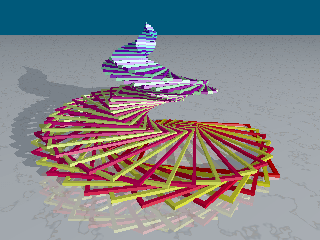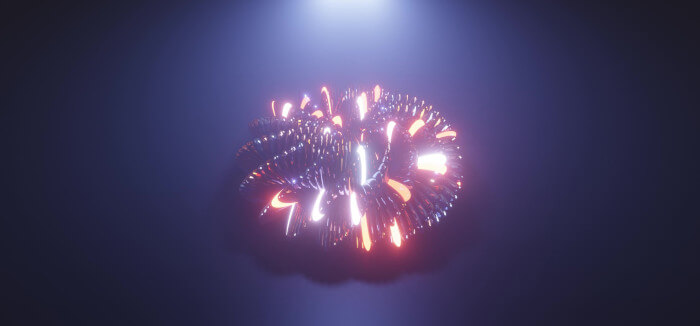POV-Ray is a full-featured ray tracer.
Ray tracers simulate objects and light sources of the real world to calculate photorealistic, computer generated images. Because of the nature of ray tracing, this process is quite CPU-intensive, at the benefit of more realistic images compared to real time rendering techniques. For example, in POV-Ray, you can model a glass prism, and you will see a spectrum in the resulting image.
POV-Ray by itself is a command-line utility that will take scene descriptions, written in a special easy-to-understand language, to produce ray-traced images (or even a sequence of images, for animations). You can either write those scene-descriptions by hand, or use external tools to generate (parts of) the scene.
Features include:
- Easy to use scene description language.
- Large library of stunning example scene files.
- Standard include files that pre-define many shapes, colors and textures.
- Very high quality output image files (up to 48-bit color).
- 16 and 24 bit color display on many computer platforms using appropriate hardware.
- Create landscapes using smoothed height fields.
- Many camera types, including perspective, orthographic, fisheye, etc.
- Spotlights, cylindrical lights and area lights for sophisticated lighting
- Photons for realistic, reflected and refracted, caustics. Photons also intera.ct with media.
- Phong and specular highlighting for more realistic-looking surfaces.
- Inter-diffuse reflection (radiosity) for more realistic lighting.
- Atmospheric effects like atmosphere, ground-fog and rainbow.
- Particle media to model effects like clouds, dust, fire and steam.
- Several image file output formats including Targa, PNG and PPM.
- Basic shape primitives such as spheres, boxes, quadrics, cylinders, cones, triangle and planes.
- Advanced shape primitives such as Tori (donuts), bezier patches, height fields (mountains), blobs, quartics, smooth triangles, text, superquadrics, surfaces of revolution, prisms, polygons, lathes, fractals, isosurfaces and the parametric object.
- Shapes can easily be combined to create new complex shapes using Constructive Solid Geometry (CSG). POV-Ray supports unions, merges, intersections and differences.
- Objects are assigned materials called textures (a texture describes the coloring and surface properties of a shape) and interior properties such as index of refraction and particle media (formerly known as “halos”).
- Built-in color and normal patterns: Agate, Bozo, Bumps, Checker, Crackle, Dents, Granite, Gradient, Hexagon, Leopard, Mandel, Marble, Onion, Quilted, Ripples, Spotted, Spiral, Radial, Waves, Wood, Wrinkles and image file mapping. Or build your own pattern using functions.
- Users can create their own textures or use pre-defined textures such as … Brass, Chrome, Copper, Gold, Silver, Stone, Wood.
- Combine textures using layering of semi-transparent textures or tiles of textures or material map files.
- Display preview of image while rendering.
- Halt and save a render part way through, and continue rendering the halted partial render later.
- SMP (symmetric multiprocessing) support.
Website: www.povray.org
Support: Wiki
Developer: The POV-Team
License: POV-RAY license

POV-Ray is written in C++. Learn C++ with our recommended free books and free tutorials.
| Popular series | |
|---|---|
| The largest compilation of the best free and open source software in the universe. Each article is supplied with a legendary ratings chart helping you to make informed decisions. | |
| Hundreds of in-depth reviews offering our unbiased and expert opinion on software. We offer helpful and impartial information. | |
| The Big List of Active Linux Distros is a large compilation of actively developed Linux distributions. | |
| Replace proprietary software with open source alternatives: Google, Microsoft, Apple, Adobe, IBM, Autodesk, Oracle, Atlassian, Corel, Cisco, Intuit, SAS, Progress, Salesforce, and Citrix | |
| Awesome Free Linux Games Tools showcases a series of tools that making gaming on Linux a more pleasurable experience. This is a new series. | |
| Machine Learning explores practical applications of machine learning and deep learning from a Linux perspective. We've written reviews of more than 40 self-hosted apps. All are free and open source. | |
| New to Linux? Read our Linux for Starters series. We start right at the basics and teach you everything you need to know to get started with Linux. | |
| Alternatives to popular CLI tools showcases essential tools that are modern replacements for core Linux utilities. | |
| Essential Linux system tools focuses on small, indispensable utilities, useful for system administrators as well as regular users. | |
| Linux utilities to maximise your productivity. Small, indispensable tools, useful for anyone running a Linux machine. | |
| Surveys popular streaming services from a Linux perspective: Amazon Music Unlimited, Myuzi, Spotify, Deezer, Tidal. | |
| Saving Money with Linux looks at how you can reduce your energy bills running Linux. | |
| Home computers became commonplace in the 1980s. Emulate home computers including the Commodore 64, Amiga, Atari ST, ZX81, Amstrad CPC, and ZX Spectrum. | |
| Now and Then examines how promising open source software fared over the years. It can be a bumpy ride. | |
| Linux at Home looks at a range of home activities where Linux can play its part, making the most of our time at home, keeping active and engaged. | |
| Linux Candy reveals the lighter side of Linux. Have some fun and escape from the daily drudgery. | |
| Getting Started with Docker helps you master Docker, a set of platform as a service products that delivers software in packages called containers. | |
| Best Free Android Apps. We showcase free Android apps that are definitely worth downloading. There's a strict eligibility criteria for inclusion in this series. | |
| These best free books accelerate your learning of every programming language. Learn a new language today! | |
| These free tutorials offer the perfect tonic to our free programming books series. | |
| Linux Around The World showcases usergroups that are relevant to Linux enthusiasts. Great ways to meet up with fellow enthusiasts. | |
| Stars and Stripes is an occasional series looking at the impact of Linux in the USA. | |
